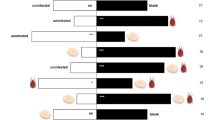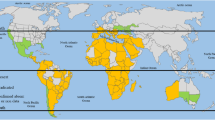Abstract
The western flower thrips (WFT), Frankliniella occidentalis (Pergande), is one of the most important thysanopteran pests belonging to the family Thripidae. This species is a cosmopolitan and serious insect pest of greenhouse and field crops worldwide. Orius laevigatus (Fiber) (Heteroptera: Anthocoridae) is an important zoophytophagous insect that attacks a wide variety of insect pests and is commercially available as a biological control agent of F. occidentalis. However, the biological control success by this predator strongly depends on the morphological characteristics and nutritional quality of the host plant. In the present study, the suitability of green bean, marigold, and strawberry as banker plants for O. laevigatus were evaluated in the laboratory condition (25 ± 1 °C, a relative humidity of 70 ± 5% with a 16-h day). The shortest and longest developmental time of whole nymphal periods of O. laevigatus was on the green bean (10.6 days) and marigold (13.2 days) plants, respectively. The highest fecundity of O. lavigatus was on the green bean (113.0 eggs) and the lowest on the marigold (38.4 eggs). The highest net reproductive rate (R0: 47.3 female/female), intrinsic rate of increase (rm: 0.10 female/female/day), finite rate of increase (λ: 1.16 female/female/day), and generation time (T: 24.1 days) were obtained on the green bean. Based on our results, the green bean can be a good candidate as a banker plant for O. laevigatus in integrated pest management programs.


Similar content being viewed by others
References
Akköprü EP, Atlihan R, Okut H, Chi H (2015) Demographic assessment of plant cultivar resistance to insect pests: a case study of the dusky-veined walnut aphid (Hemiptera: Callaphididae) on five walnut cultivars. J Econ Entomol 108:378–387
Armer CA, Wiedenmann RN, Bush DR (1998) Plant feeding site selection on soybean by the facultatively phytophagous predator Orius insidiosus. Entomol Exp Appl 86:109–118
Ballal CR, Yamada K (2016) Antocorid predator. In: Omkar (ed) Ecofriendly pest management for food security. Elsevier, London, pp 329–366 727pp
Banihashemi S, Hosseini MR, Golizadeh H, Sankaran S (2017) Critical success factors (CSFs) for integration of sustainability into construction project management practices in developing countries. Int J Proj Manag 35:1103–1119
Ben-Mahmoud S, Smeda J, Chappell T, Stafford-Banks C, Kaplinsky C, Anderson T (2018) Acylsugar amount and fatty acid profile differentially suppress oviposition by western flower thrips, Frankliniella occidentalis, on tomato and interspecific hybrid flowers. PLoS One 13:e0201583
Bonte M, De Clercq P (2011) Influence of predator density, diet and living substrate on developmental fitness of Orius laevigatus. J Appl Entomol 135:343–350
Bonte J, Vangansbeke D, Maes S, Bonte M, Conlong D, De Clercq P (2012) Moisture source and diet affect development and reproduction of Orius thripoborus and Orius naivashae, two predatory anthocorids from southern Africa. J Insect Sci 12:1–16
Borzoui H, Naseri B, Mohammadzadeh-Bidarani M (2016) Adaptation of Habrobracon hebetor (Hymenoptera: Braconidae) to rearing on Ephestia kuehniella (Lepidoptera: Pyralidae) and Helicoverpa armigera (Lepidoptera: Noctuidae). J Insect Sci 16:1–7
Borzoui E, Nouri-Ganbalani G, Naseri B (2017) In vitro and in vivo effects of α-amylase inhibitor from Avena sativa seeds on life history and physiological characteristics of Sitotroga cerealella (Lepidoptera: Gelechiidae). J Insect Sci 17(108):1–7
Borzoui E, Bandani AR, Goldansaz SH, Talaei-Hassanlouei R (2018) Dietary protein and carbohydrate levels affect performance and digestive physiology of Plodia interpunctella (Lepidoptera: Pyralidae). J Econ Entomol 111(2):942–949
Brownbridge M, Buitenhuis R, Murphy G, Waite M, Scott-Dupree C (2013) Banker plants, trap crops and other bioprotection developments in Canadian greenhouse floriculture. In: Proceedings of the 4th International Symposium on Biological Control of Arthropods. Pucón, Chile, 4-8 March. (eds. Mason, P. G., Gillespie, D. R. and Vincent, C.) Pucon, Chile
Bueno VHP (1999) Protected cultivation and research on biological control of pests in greenhouses in Brazil. IOBC WPRS Bull 22:21–24
Calvo FJ, Bolckmans K, Belda JE (2009) Development of a biological control-based integrated pest management method for Bemisia tabaci for protected sweet pepper crops. Entomol Exp Appl 133:9–18
Chi H (1988) Life table analysis incorporating both sexes and variable developmental rates among individuals. Environ Entomol 17:26–34
Chi H (2015) TWOSEX-MSChart: a computer program for the age-stage, two-sex life table analysis. (http://140.120.197.173/Ecology/Download/TWOSEX-MSChart.zip). Accessed 25 June 2015
Chi H, Liu H (1985) Two new methods for the study of insect population ecology. Bull Inst Zool Acad Sin 24:225–240
Chi H, Su HY (2006) Age-stage, two-sex life tables of Aphidius gifuensis (Ashmead) (Hymenoptera: Braconidae) and its host Myzus persicae (Sulzer) (Homoptera: Aphididae) with mathematical proof of the relationship between female fecundity and the net reproductive rate. Environ Entomol 35:10–21
Coll M, Ridgway RL (1995) Functional and numerical responses of Orius insidiosus (Heteroptera: Anthocoridae) to its prey in different vegetable crops. Ann Entomol Soc Am 88:732–738
Costa CA, Guiné RP, Costa DV, Correia HE, Nave A (2019) Pest control in organic farming. In: Organic Farming. Elsevier, pp 41–90
Cottrell TE, Yeargan KV (1998a) Effect of pollen on Coleomegilla maculata (Coleoptera: Coccinellidae) population density, predation, and cannibalism in sweet corn. Environ Entomol 27:1402–1410
Cottrell TE, Yeargan KV (1998b) Influence of a native weed, Acalypha ostryaefolia (Euphor biaceae), on Coleomegilla maculata (Coleoptera: Coccinellidae) population density, predation, and cannibalism in sweet corn. Environ Entomol 27:1375–1385
Efron B, Tibshirani RJ (1993) An introduction to the bootstrap. Chapman and Hall, New York, p 436
Elimem M, Harbi A, Limem-Sellemi E, Ben Othmen S, Chermiti H (2018) Orius laevigatus (Insecta; Heteroptera) local strain, a promising agent in biological control of Frankliniella occidentalis (Insecta; Thysanoptra) in protected pepper crops in Tunisia. Euro-Mediterranean J Environ Integ 3:5
Farhadi R, Allahyari H, Chi H (2011) Life table and predation capacity of Hippodamia variegate (Col. Coccinellidae) feeding on Aphis fabae (Hem. Aphididae). Biol Control 59:83–89
Gilbertson RL, Batuman O, Webster CG, Adkins S (2015) Role of the insect supervectors Bemisia tabaci and Frankliniella occidentalis in the emergence and global spread of plant viruses. Ann Rev Virol 2:67–93
Hamdan AJ, Abu-Awad I (2007) Effect of host plants on predator prey relationship between predatory bug, Orius laevigatus (fiber) [Hemiptera: Anthocoridae] and tobacco whitefly, Bemisia tabaci (Gennadius) [Homoptera: Aleyrodidae]. An-Najah Univ J Res 21:86–99
Jalalizand A, Karimy A, Ashouri A, Hosseini M, Golparvar AR (2012) Effect of host plant morphological features on functional response of Orius albidipennis (Hemiptera: Anthocoridae) to Tetranychus urticae (Acari: Tetranychidae). Res Crop 13:378–384
Kim DS, Lee JH (2002) Egg and larval survivorship of Carposina sasakii (Lepidoptera: Carposinidae) in apple and peach and their effects on adult population dynamics in orchards. Environ Entomol 31:686–692
Landis DA, Wratten SD, Gurr GM (2000) Habitat management to conserve natural enemies of arthropod pests in agriculture. Annu Rev Entomol 45:175–201
Lorenzo ME, Bao L, Mendez L, Grille G, Bonato O, Basso C (2019) Effect of two oviposition feeding substrates on Orius insidiosus and Orius tristicolor (Hemiptera: Anthocoridae). Fla Entomol 102:395–402
Lundgren JG, Fergen JK, Riedell WE (2008) The influence of plant anatomy on oviposition and reproductive success of the omnivorous bug Orius insidiosus. Anim Behav 75:1495–1502
Madadi H, Enkegaard A, Brodsgaard HF, Kharrazi-Pakdel A, Mohaghegh J, Ashouri A (2007) Host plant effects on the functional response of Neoseiulus cucumeris to onion thrips larvae. J Appl Entomol 131:728–733
Maia AHN, Luiz AJB, Campanhola C (2000) Statistical inference on associated fertility life table parameters using jackknife technique: computational aspects. J Econ Entomol 93:511–518
Majd-Marani S, Naseri B, Nouri-Ganbalani G, Borzoui E (2017) The effect of maize hybrid on biology and life table parameters of the Khapra beetle, Trogoderma granarium Everts (Coleoptera: Dermestidae). J Econ Entomol 110:1916–1922
Moayeri HRS, Ashouri A, Brødsgaard HF, Enkegaard A (2006) Odour-mediated preference and prey preference of Macrolophus caliginosus between spider mites and green peach aphids. J Appl Entomol 130:504–508
Mohammadzadeh M, Izadi H (2018) Different diets affecting biology, physiology and cold tolerance of Trogoderma granarium Everts (Coleoptera: Dermestidae). J Stored Prod Res 76:58–65
Montero-Astúa M, Ullman DE, Whitfield AE (2016) Salivary gland morphology, tissue tropism and the progression of tospovirus infection in Frankliniella occidentalis. Virology 493:39–51
Mortazavi N, Aleosfoor M, Minaei K (2015) Comparison of seven methods for rearing western flower thrips Frankliniella occidentalis (Thysanoptera: Thripidae). Iran Agric Res 34:15–20
Mouden S, Sarmiento KF, Klinkhamer PGL, Leiss KA (2017) Integrated pest management in western flower thrips: past, present and future. Pest Manag Sci 73:813–822
Naseri B, Abedi Z, Abdolmaleki A, Jafary-Jahed M, Borzoui E, Mansouri SM (2017) Fumigant toxicity and sublethal effects of Artemisia khorassanica and Artemisia sieberi on Sitotroga cerealella (Lepidoptera: Gelechiidae). J Insect Sci 15(100):1–7
Nemati-Kalkhoran M, Razmjou J, Borzoui E, Naseri B (2018) Comparison of life table parameters and digestive physiology of Rhyzopertha dominica (Coleoptera: Bostrichidae) fed on various barley cultivars. J Insect Sci 18(31):1–9
Nouri-Ganbalani G, Borzoui E, Shahnavazi M, Nouri A (2018) Induction of resistance against Plutella xylostella (L.) (Lep.: Plutellidae) by jasmonic acid and mealy cabbage aphid feeding in Brassica napus L. Front Physiology 9:859
Nouri-Ganbalani G, Naseri B, Majd-Marani S, Borzoui E (2020) Canola cultivars affect nutrition and cold hardiness of Plutella xylostella (L.) (Lepidoptera: Plutellidae). Int J Trop Insect Sci. https://doi.org/10.1007/s42690-020-00125-8
Ogada PA, Moualeu DP, Poehling HM (2016) Predictive models for tomato spotted wilt virus spread dynamics, considering Frankliniella occidentalis specific life processes as influenced by the virus. PLoS One 11:e0154533
Pérez-Hedo M, Urbaneja A (2015) Prospects for predatory mirid bugs as biocontrol agents of aphids in sweet peppers. J Pest Sci 88:65–73
Riudavets J (1995) Predators of Frankliniella occidentalis (Perg.) and Thrips tabaci Lind.: a review. Wageningen Agricultural University papers 43-87
Sanchez JA, Gillespie DR, McGregor RR (2004) Plant preference in relation to life history traits in the zoophytophagous predator Dicyphus hesperus. Entomol Exp Appl 112:7–19
Sarkar SC, Wang E, Zhang Z, Wu S, Lei Z (2019) Laboratory and glasshouse evaluation of the green lacewing, Chrysopa pallens (Neuroptera: Chrysopidae) against the western flower thrips, Frankliniella occidentalis (Thysanoptera: Thripidae). Appl Entomol Zool 54:115–121
Shaltiel L, Coll M (2004) Reduction of pear psylla damage by the predatory bug Anthocoris nemoralis (Heteroptera: Anthocoridae): the importance of orchard colonization time and neighboring vegetation. Biocontrol Sci Tech 14:811–821
Shipp JL, Wang K (2003) Evaluation of Amblyseius cucumeris (Acari: Phytoseiidae) and Orius insidiosus (Hemiptera: Anthocoridae) for control of Frankliniella occidentalis (Thysanoptera: Thripidae) on greenhouse tomatoes. Biol Control 28:271–281
Silva IM, Martins GF, Melo CR, Santana AS, Faro RR, Blank AF, Alves PB, Picanço MC, Cristaldo PF, Araújo APA (2018) Alternative control of Aedes aegypti resistant to pyrethroids: lethal and sublethal effects of monoterpene bioinsecticides. Pest Manag Sci 74:1001–1012
Silveira LCP, Bueno VHP, Van Lenteren JC (2004) Orius insidiosus as biological control agent of thrips in greenhouse chrysanthemums in the tropics. Bull Insectol 57:103–109
Tsai JH, Wang JJ (2001) Effects of host plants on biology and life table parameters of Aphid spiraecola (Homoptera: Aphididae). Environ Entomol 30:45–50
Urbaneja A, Tapia G, Stansly P (2005) Influence of host plant and prey availability on developmental time and survivorship of Nesidiocoris tenuis (Het.: Miridae). Biocontrol Sci Tech 15:513–518
White NDG, Leesch JG (1995) Chemical control, in integrated management of insects in stored products. Marcel Dekker, New York
Zeng F, Cohen AC (2000) Demonstration of amylase from the zoophytophagous anthocorid Orius insidiosus. Arch Insect Biochem Physiol 44:136–139
Zhang NX, Messelink GJ, Alba JM, Schuurink RC, Kant MR, Janssen A (2018) Phytophagy of omnivorous predator Macrolophus pygmaeus affects performance of herbivores through induced plant defences. Oecologia 186:101–113
Acknowledgments
The work received financial support by the Vali-e-Asr University of Rafsanjan (Rafsanjan, Iran) which is greatly appreciated.
Author information
Authors and Affiliations
Corresponding author
Ethics declarations
Disclosure statement
No potential conflict of interest was reported by the authors.
Additional information
Publisher’s note
Springer Nature remains neutral with regard to jurisdictional claims in published maps and institutional affiliations.
Rights and permissions
About this article
Cite this article
Kordestani, M., Mahdian, K., Baniameri, V. et al. Effect of three oviposition feeding substrates on biology and life table parameters of Orius laevigatus. Int J Trop Insect Sci 41, 1523–1529 (2021). https://doi.org/10.1007/s42690-020-00351-0
Received:
Accepted:
Published:
Issue Date:
DOI: https://doi.org/10.1007/s42690-020-00351-0




